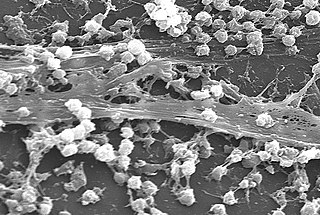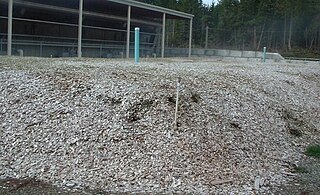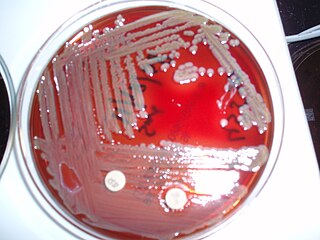
A biofilm is an syntrophic community of microorganisms in which cells stick to each other and often also to a surface. These adherent cells become embedded within a slimy extracellular matrix that is composed of extracellular polymeric substances (EPSs). The cells within the biofilm produce the EPS components, which are typically a polymeric combination of extracellular polysaccharides, proteins, lipids and DNA. Because they have three-dimensional structure and represent a community lifestyle for microorganisms, they have been metaphorically described as "cities for microbes".

Biofiltration is a pollution control technique using a bioreactor containing living material to capture and biologically degrade pollutants. Common uses include processing waste water, capturing harmful chemicals or silt from surface runoff, and microbiotic oxidation of contaminants in air. Industrial biofiltration can be classified as the process of utilizing biological oxidation to remove volatile organic compounds, odors, and hydrocarbons.
A slime layer in bacteria is an easily removable, unorganized layer of extracellular material that surrounds bacteria cells. Specifically, this consists mostly of exopolysaccharides, glycoproteins, and glycolipids. Therefore, the slime layer is considered as a subset of glycocalyx.

Streptococcus mutans is a facultatively anaerobic, gram-positive coccus commonly found in the human oral cavity and is a significant contributor to tooth decay. It is part of the "streptococci", an informal general name for all species in the genus Streptococcus. The microbe was first described by James Kilian Clarke in 1924.

The class Flavobacteriia is composed of a single class of environmental bacteria. It contains the family Flavobacteriaceae, which is the largest family in the phylum Bacteroidota. This class is widely distributed in soil, fresh, and seawater habitats. The name is often spelt Flavobacteria, but was officially named Flavobacteriia in 2012.
Dark fermentation is the fermentative conversion of organic substrate to biohydrogen. It is a complex process manifested by diverse groups of bacteria, involving a series of biochemical reactions using three steps similar to anaerobic conversion. Dark fermentation differs from photofermentation in that it proceeds without the presence of light.

Citrobacter freundii is a species of facultative anaerobic Gram-negative bacteria of the family Enterobacteriaceae which currently consists of 13 recognized species. These bacteria have a rod shape with a typical length of 1–5 μm. Most C. freundii cells have several flagella used for locomotion, although some non-motile taxa do not. C. freundii is a soil-dwelling microorganism, but can also be found in water, sewage, food, and the intestinal tracts of animals and humans. The genus Citrobacter was discovered in 1932 by Werkman and Gillen. Cultures of C. freundii were isolated and identified in the same year from soil extracts.

Moving bed biofilm reactor (MBBR) is a type of wastewater treatment process that was first invented by Professor Hallvard Ødegaard at Norwegian University of Science and Technology in the late 1980s. The process takes place in an aeration tank with plastic carriers that a biofilm can grow on. The compact size and cheap wastewater treatment costs offers many advantages for the system. The main objective of using MBBR being water reuse and nutrient removal or recovery. In theory, wastewater will be no longer considered waste, it can be considered a resource.
Ji Hee Kim is an Antarctic researcher, best known for being the Principal Investigator for comprehensive environmental monitoring and construction of the long term environmental database at South Korea's King Sejong Station.
Nocardioides salsibiostraticola is a Gram-positive, aerobic, non-spore-forming and non-motile bacterium from the genus Nocardioides which has been isolated from biofilm from coastal seawater from the Norwegian Sea.
Dokdonia donghaensis is a strictly aerobic, gram-negative, phototrophic bacterium that thrives in marine environments. The organism can grow at a broad range of temperatures on seawater media. It has the ability to form biofilms, which increases the organism's resistance to antimicrobial agents, such as tetracycline.
Microbacterium xylanilyticum is a Gram-positive, non-spore-forming, xylan-degrading and non-motile bacterium from the genus Microbacterium which has been isolated from sludge in Cheongju in Korea.
Chelatococcus caeni is a Gram-negative, non-spore-forming, rod-shaped and motile bacterium from the genus of Chelatococcus which has been isolated from biofilm reactor sludge in Korea.
Actinotalea caeni is a Gram-positive, rod-shaped, non-spore-forming and non-motile bacterium from the genus Actinotalea which has been isolated from sludge from Korea.
Diaphorobacter polyhydroxybutyrativorans is a Gram-negative, facultatively aerobic and rod-shaped bacterium from the genus of Diaphorobacter which has been isolated from biofilm from a denitrifying reactor in Beijing in China. Diaphorobacter polyhydroxybutyrativorans has the ability to degrade poly(3-hydroxybutyrate-co-3-hydroxyvalerate).
Rhodanobacter is a Gram-negative and non-motile genus of Pseudomonadota.
Rhodanobacter thiooxydans is a Gram-negative, non-spore-forming and non-motile bacterium from the genus of Rhodanobacter which has been isolated from biofilm from Daejon in Korea.
Flaviflexus equikiangi is a Gram-positive, non-spore-forming and cocci-shaped bacterium from the genus of Flaviflexus which has been isolated from the feces of a Kiang.
Flaviflexus huanghaiensis is a Gram-positive and non-motile bacterium from the genus of Flaviflexus which has been isolated from sediments from the coast of Qingdao.





